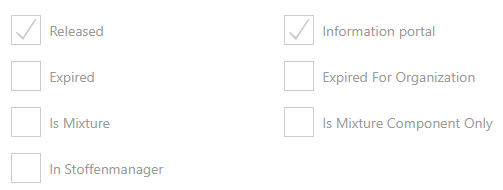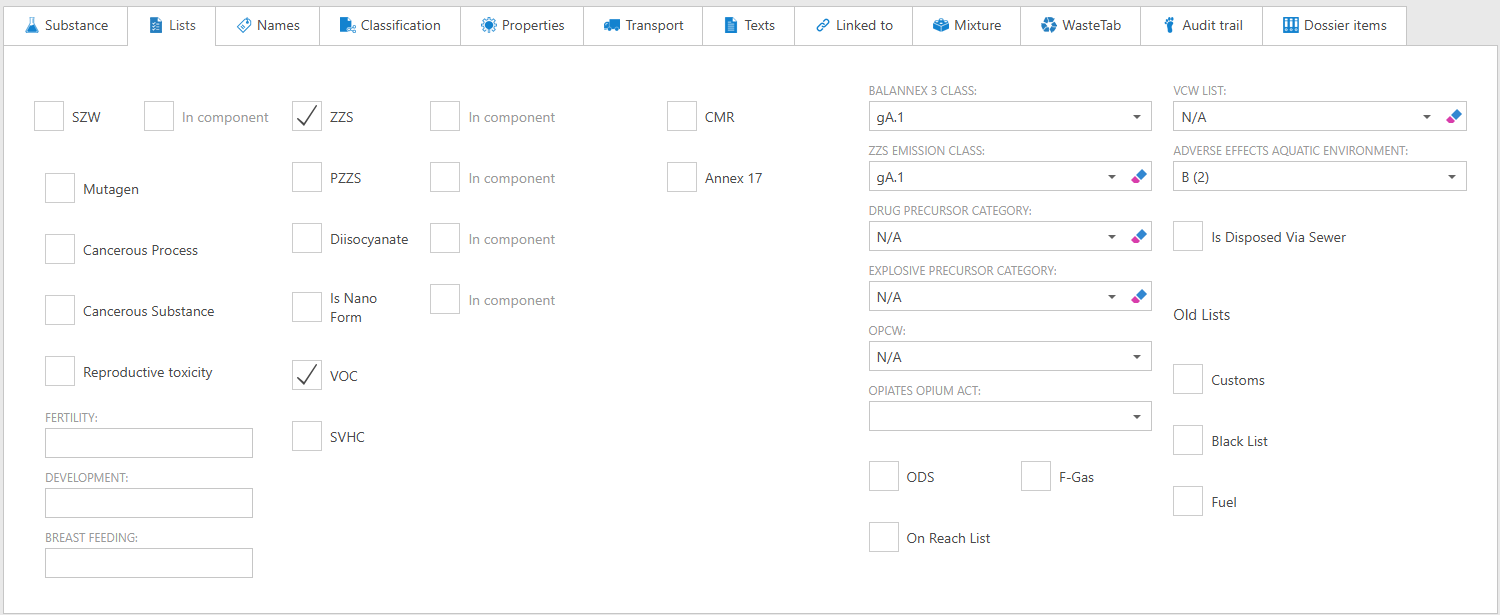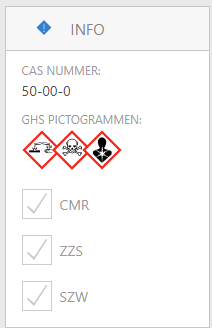

| Menu > Go to > Substance |
Due to the enormous amount of data that can be recorded for a substance, the screen is divided into several tabs. If you click on one of the tabs, you will see additional information. If you want to modify the information of a substance, you can do so by clicking the Edit-icon.
If you want to export data, you can only do this for the items labeled "Export to".
This screen enables you to perform a variety of actions on the selected substance:
Here is the general identifying information of the substance
You can choose the name to use for a substance within your organization. The names tab includes a field for each language where you can select a name for a substance.
Choosing a name is not mandatory; in such cases, the displayed name will be chosen automatically, as described below.
The name of the substance displayed on this tab at the top left, which is also used as the default name across the application, is dynamically derived. This is looked up in the set of names that were entered using the following methodology:
If a substance's name from an external database ends with '(*)', it indicates that the external database source has identified the substance as expired.
The fields listed below have either been imported from the database or entered manually (for a SOFOS 360® substance).
Attention! The term "EC-number" is currently preferred to the outdated "EINECS number" designation. Therefore, EC-number has been added in SOFOS360. It can be found on the "Substance" tab in the mutation screen of a substance.
These options will be available on the substance detail screen.

The checkbox CMR is automatically checked if an H-phrase is linked to a CMR indication (H340, H341, H350, H351, H360, H361, and H362). You can also manually check the CMR checkbox and save the item; it will turn red if the manual adjustment does not match the information from the database.
The checkboxes for PZZS, ZZS, SZW (Fertility, Development, Breastfeeding), VOS, Drug Precursors, ODP and F-gases, SVHC, Diisocyanate, OPCW, Opiate List, REACH Authorization, BAL Annex 3 and ZZS emission class can be automatically set when saving the substance if the corresponding lists are uploaded and the substance appears on one or more of these lists.
Additionally, you can indicate if the substance appears on one or more of the following lists:
Lastly, some 'old' lists that were used in the past will be removed from SOFOS360 in the future. These are:
If the substance is a mixture, it might have components that appear on the SZW, ZZS, PZZS, Diisocyanate list or have a nanoform. In such cases, a 'In component' checkbox will be shown next to the relevant list.

You will find various names in different languages (synonyms) on this tab. By default, the given name in the current language of the browser will be used as "the name". However, if you prefer using a different name instead of "the name", you can enter the preferred term and indicate which of the available names should be used.
You can only add synonyms to the list of names if it concerns a substance from one of the databases. When you update the substance with the most recent data from the databases, these synonyms will remain.
Here you will find:
You can modify the icon per component to your preferences (personalize) and and reset it to the standard settings using the Reset icon.
You can also export data per component. However, it is not possible to export all data from the entire sheet at once.
You can add the preferred pictograms by clicking "Link" or "Unlink" button.
Here you will find the properties of the substance in four tabs.
|
On the tab Aspects you will find a description of the:
|
|
 |
On the Physical properties tab you will find information about, among other things:
A substance's structural formula can be represented graphically. This involves using the magnifying glass button to search a public database for a substance by its CAS number or name, and if a specific substance is found, the so-called SMILES description of that substance is generated. An image is then created based on the description. You can also input the SMILES description yourself and generate an image using the aforementioned button. For instance, the SMILES description of dinitrobenzene is:C1(=CC=CC=C1NO)N(O)O |
 |
On the Free text tab you will find an overview of:
|
 |
On the Control parameters tab you will find an overview of:
There are several control parameter sections:
If you want to add a control parameter, you can add values yourself or select from the drop-down list (opened by clicking the black arrow ()). You will see that every parameter type and control parameter section has a separate window where you can enter the required values. |
Here you will find the transport regulations for the selected substance:
Attention! The ADR class and packing group are available in the Workplace Instruction Card (WIC). They can be found right above the Gevi number.
You can find the chapter numbers and, if available, the section numbers of the substance here, along with the available (fixed) texts. These texts include things like how to provide first aid, what kind of container is safe to put substances in, how to handle waste, and more.
You can add any texts that are relevant to the given substance. You have the option of selecting texts from multiple sources or just SOFOS texts. After choosing a chapter, you can check all the texts that apply by putting a checkmark in front of each one. You can add this all at once, close the window, and save your selection.
You can use the 'Add new text' button to add new text to your library. After adding, the text is immediately available for linking to the current substance and the other substances.
Here you will find the links to other elements within SOFOS360:
If there are no links, you will see "No data available".
Here you will find an overview of the mixture components:
and possibly what the substance is part of:
If no information is known or entered, you will see "No data available".
If you use the 'CLP' module, fill in the 'Physical state during use' field, to perform a correct calculation.
Here you will find an overview of the history of the substance. You see:
If there is no processing history, you will see "No data available".
You can now permanently display a small screen on the substance screen with the most crucial safety information about the substance that is currently in use by selecting the new "Always show CMR information on the substance screen" option in the user settings.

Copyright© 2024 ITIS